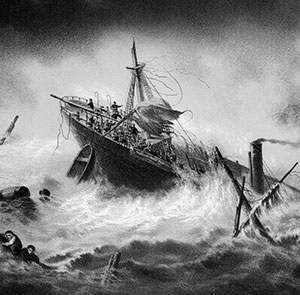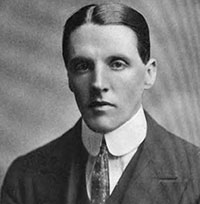October 26
Published in On this Day listing- 1859

Above: A contemporary depiction of the wreck of the Royal Charter on 26 October 1859.
The Royal Charter, a steamship that also carried sail, en route from Melbourne to Liverpool, was wrecked in a violent storm off the northern coast of Anglesey. On board were 450 passengers and crew, including many miners returning from the diggings in Australia with large amounts of gold about their persons, and a consignment of gold as cargo. The ‘Royal Charter storm’, so called because she was the biggest casualty, smashed sea-walls and harbours along the Welsh seaboard in winds reaching hurricane force 12 and sank some 200 ships with the loss of 800 lives. At 11pm the previous evening, with winds at speeds beyond the range of the Beaufort scale, the Royal Charter managed to anchor off the Anglesey coast. A few hours later, however, with her passengers in high spirits and preparing to disembark, her chains snapped and she was driven by a rising tide onto a rocky ledge and pounded to pieces. There were just 40 survivors, amongst whom there were no women and children. Apart from the miners, who were weighed down by their gold, few were drowned but rather were killed by being dashed against the rocks. And, for once, the Irish were lucky: most of those who had boarded her two months earlier had disembarked at Cobh, her last port of call before sailing to her doom. The subsequent tribunal of inquiry brought good news for seafarers. Admiral Robert Fitzroy of the British Navy was commissioned to organise a system of ‘storm warnings’ to be sent to threatened coastal areas over the newly invented electric telegraph. One year later the first gale warning service was established, and in 1867 the first shipping forecast.
- 1930

Above: F.E. Smith, 1st Earl of Birkenhead, who died on 30 September 1930.
F.E. Smith (58), 1st Earl of Birkenhead, politician, died. Elected Conservative MP for Liverpool—then the stronghold of Orangeism in Britain—in 1906, Birkenhead first appeared in the nationalist narrative during the Home Rule crisis (1912), when he served as Edward Carson’s aide-de-camp, a role which earned him the moniker ‘Galloper Smith’. Four years later he compounded his notoriety by prosecuting the Crown’s case against Sir Roger Casement but absolved himself to some degree during the Treaty negotiations. There he struck up a solid rapport with Michael Collins, each man respecting the other’s patriotism and plain speaking, concluding with a much-quoted exchange on signing the document—Birkenhead telling Collins that he had just signed his ‘political death warrant’, the latter replying that he had signed his ‘actual death warrant’. From a British prospective, ‘FE’—he was always known by his initials—was considered one of the most brilliant intellects of his day. After Oxford, where in his own words he picked up most of ‘the glittering prizes’, he embarked on a lucrative legal career before bringing his charisma and oratorial skills to bear in politics, making the most famous maiden speech in the House of Commons. In 1918, at the age of 46, he became the youngest lord chancellor in 300 years. Thereafter, however, it was all downhill. Already castigated for his extravagant lifestyle and lifelong friendship with Winston Churchill, there were increasing reports about his heavy drinking, and though he remained in politics until 1928, serving in Stanley Baldwin’s government, and continued to publish legal and historical works, he was considered by then as a character from a bygone age. He succumbed to the ravages of alcohol two years later.
- 1916 François Mitterand, leader of the French Socialist Party and president of France (1981–95), born in Jarnac, Charente, the son of devout Catholic parents.
- 1588 The Girona, a 700-ton Neapolitan galleass of the Spanish Armada, was wrecked off Lacada Point, Co. Antrim.
- 1972 Igor Sikorsky, Russian-born engineer who developed the first successful helicopter (1939), died in Connecticut, USA.
















